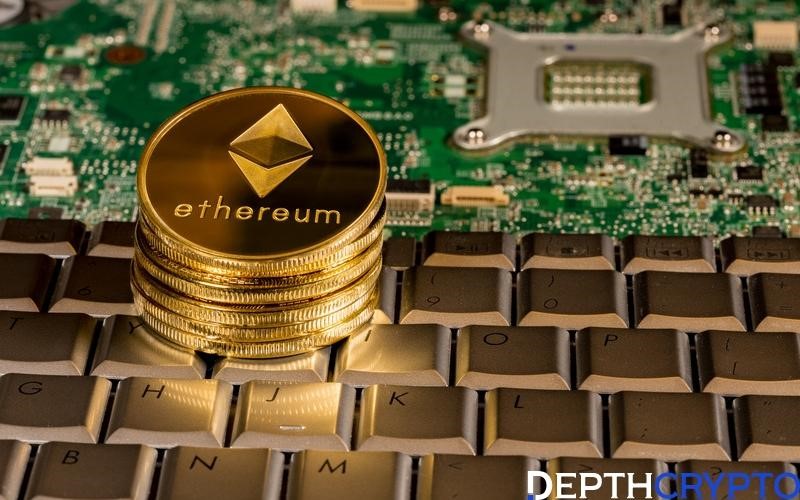
On September 15, 2022, the Ethereum Blockchain crossed a significant milestone when it transitioned from PoW to PoS Blockchain — an unfavorable move for Ethereum miners.
Before the Merge, you could contribute to the Blockchain by mining Ethereum blocks. However, mining Ethereum became obsolete after the Merge.
Want to learn how to contribute to Ethereum’s PoS Blockchain network? You’re on the right page.
In this article, we discussed Ethereum mining before and after the Merge and how you can participate in the network.
What is Ethereum?

Initially built as an upgrade to Bitcoin, the Ethereum Blockchain is the Powerhouse of most NFTs, smart contracts, and dApps.
Ethereum is the second-largest cryptocurrency by price and market cap [1] and the most sought-after altcoin. Like Bitcoin, Ethereum is implemented on its blockchain network.
Ethereum’s popularity stems from its several utilities, which increase the adoption of its native currency, Ether (ETH).
The Blockchain provides a platform for secure verification and execution of application code, known as smart contracts.
A smart contract is a self-executing program with predetermined conditions to be met before the program can run.
Smart contracts provide security, transparency, and decentralization. It’s through smart contracts [2] that developers can create projects on any Blockchain network.
According to dApps stats, Ethereum has the largest number of projects, with about 2,970 dApps built on it [3]. Thus, many developers embrace the network’s offer in the wake of NFTs and web3 applications.
What is Ethereum Mining?

The term “mining” is common in crypto. It relates to the fact that the crypto community likened cryptocurrencies to precious metals like gold. And in the traditional sense, these metals are obtained via mining.
Thus, similar to Bitcoin mining, the term “mining” applied to Ethereum due to a consensus mechanism known as “Proof of Work.”
The mechanism involves creating new blocks on the Ethereum blockchain by solving a complex set of mathematical puzzles using a computer. Its purpose is to validate the entries on the network and keep its database secure and reliable.
While creating new blocks is known as mining, the computers involved are known as “miners.”
In the traditional sense, miners get paid for digging out precious metals from the earth. The same holds in Ethereum mining, as miners are rewarded for securing the network.
In the Proof of Work consensus mechanism, anyone with spare processing power can use their computers for mining.
With the right Graphics Processing Units on your computer, you could mine ETH. However, more specialized processors were created to provide more mining power than regular computers.
The introduction of specialized processors for mining made it more difficult to use computers with regular processors to mine ETH. Meanwhile, as more people used specialized processors to improve their mining power, the difficulty levels of the complex puzzles increased.
Before the transition known as The Merge, Ethereum Blockchain operated on this Proof of Work (PoW) consensus mechanism. But now that the merge has finally taken place, the consensus mechanism used in validating data on the network has changed. Below are the pros and cons of the Proof of Work model:
Pros

1. The Proof of Work model offers a high level of security
Due to its decentralization, many users can provide hashing power, which makes it difficult to take over the network. You must control more than 50% of the mining power [4] to take over the network.
2. Decentralization
PoW verifies crypto transactions without the need for a third party. It also prevents individuals, nodes, computers, or external organizations from tampering with the database. Thus, enhancing the authenticity and transparency of each transaction.
3. ETH Reward
Once you have the processing capabilities required to validate transactions on the Ethereum network, you can earn ETH in exchange for securing the network.
Cons

1. Low transaction speed
PoW is characterized by slow speed, which makes the entire process inefficient. The network can handle only a few transactions at once. It could also take about 10 minutes to complete a block. Hence, leading to poor network scalability.
2. Energy intensive
At this time, there are a lot of concerns about global warming and climate change. According to an analysis by Cambridge University, the PoW network’s annual energy consumption is more than that in Argentina [5].
3. Increased mining difficulty
Due to the use of more specialized processors and competition among miners, mining required more difficult computational puzzles. Even worse, leading to the use of more hardware with higher energy demand, which contributes to the preceding point.
4. Costly equipment
Setting up PoW sophisticated, high-performance equipment is costly and may wear out quickly. Thus, preventing the greater public from contributing to a blockchain network.
The transition of Ethereum from “Proof of Work” to “Proof of Stake.”
On September 15, 2022, the merge was successfully deployed. It took the Ethereum network through a transition from the Proof of Work Consensus mechanism to that of Proof of Stake.
If you were looking to go into Ethereum mining, you just can’t anymore. For you to mine a cryptocurrency, the network needs to be operating on a Proof of Work consensus mechanism.
Unlike the PoW mechanism, the Ethereum network will no longer rely on the processing capabilities of computers to validate transactions and create new blocks.
Instead, to qualify as a validator, you will be required to stake 32 ETH. The process doesn’t involve competition between miners to validate transactions. Rather a validator is selected at random to secure the network.
With the Proof-of-Stake mechanism, validators do not get rewarded with ETH. This means that no new ETH is created. However, as a validator, you will be rewarded with the transaction fees paid to process that transaction.
In this new system, validators are now known as forgers rather than miners. If you want to become a forger but do not have the requisite 32 ETH, you can become a validator for a fraction of the 32 ETH required by joining a staking pool.
You can combine the amount of ETH you have with other users to meet the requirements. You will be issued a fraction of the rewards after a predetermined period.
How does Proof-of-stake work?

In Proof of Stake, validators are randomly selected to create a new block. If you were chosen to secure the network at that point, the ETH you’ve staked acts as collateral. Why do you have to do this?
The purpose of the collateral is to discourage wrong behaviors such as dishonesty. For example, a validator can decide to create a transaction between two Ethereum addresses that they own to cheat the network and earn a quick buck. Transactions are accessible to anyone, and if an irregularity is discovered, it can be reported, and a guilty validator will be punished.
To punish an errant validator, all or part of the ETH staked by the validator will be burnt in a process called slashing. This can also happen if a validator fails to validate for whatever reason. The PoS process ensures that validators are reliable.
When you complete a validation, you will be rewarded with the transaction fees. This is quite profitable, especially considering that you won’t spend much on electricity.
Also, because you require ETH to become a validator, it increases the demand for ETH. The increase in demand due to PoS also leads to a positive impact on the price.
Validation computations on PoS are also easier to solve, and a single computer can do it in no time. This is in contrast to PoW, where computations are made very difficult due to the number and sophistication of the computers used.
The Ethereum network’s transition to proof of stake has led to a drastic reduction in energy usage. Ethereum has cut its energy consumption by more than 99% [6] following the new update.
Moreso, according to Ethereum co-founder,
Pros

1. Massive decarbonization
The PoS model has cut global energy consumption by 0.2%, making Ethereum energy-efficient and eco-friendly. A big part of this is that it doesn’t involve a competitive process whereby users go for specialized processing units that consume a lot of energy.
2. Increased efficiency and transactions speed
Ethereum 2.0 now processes transactions faster, impacting the number of transactions that can be handled simultaneously. Thus, promoting scalability.
Cons

1. Semblance of centralization
Early adopters and people with more money who stake more ETH can dominate and sway the Blockchain network.
2. Susceptible to attack: 51% attack potential
This happens when an individual or organization controls more than 50% of the network. With such massive control, the individual can manipulate the network with malicious intent.
Another possible attack is the “Denial of Service” attack, where one user can disrupt the validation process by identifying and locking out the next person that is up for the validator role and taking it over.
Will the Proof of Stake transition kill Ethereum mining?

Ethereum mining, as we know it, is gone. The transition to proof of stake means that Ethereum miners and mining are now obsolete. Validation of transactions on the Ethereum network is now up to users who meet staking requirements.
Individuals that mined Ethereum in the past will now have to dump their mining equipment or turn to other PoW-supported networks. The easiest route would be to turn to the Ethereum classic network and mine ETC. That could be problematic for existing ETC miners because competition on the network will increase.
Some miners have publicly opposed the switch to PoS and are proposing a hard fork [8] to keep Ethereum mining alive. Miners like Chandler Guo [7] have argued that there will be a loss of mining jobs with Ethereum 2.0.
Table: Ethereum Proof-of-work vs. Ethereum 2.0 Proof-of-stake model
| Features | Proof of Work | Proof of Stake |
| Participants | They are known as miners. They compete to solve mathematical puzzles to secure the network. | They are known as forgers. A forger is selected to create a new block. |
| Requirements | Processors are capable of mining Ethereum. | 32 ETH. |
| Rewards | There is a block reward in the form of a new ETH. | There is no block reward. However, the forger earns the transaction fees on that block. |
| Creation of new ETH | New ETH is created to reward miners. | No new ETH is created. |
| Energy consumption | Energy intensive. | Energy efficient. and eco-friendly. |
| Adding malicious blocks | To add a malicious block, an individual must own 51% of the computing power used for mining on the network. (This isn’t easy). | A hacker would have to own 51% of all Ethereum to be able to execute an attack. (This is more likely). |
Conclusion
Now a POS Blockchain, Ethereum no longer needs miners. Instead, it requires validators to oversee and validate crypto transactions.
Depending on your goals, you can participate in the Ethereum network by becoming a validator when you stake 32 ETH or fractional ETH in a staking pool.
Or you could buy, trade, or invest in Ether on popular crypto exchanges like Coinbase or Binance.US.
Meanwhile, it’s essential to understand the risks associated with trading cryptocurrencies and your risk tolerance. Also, remember to invest what you can afford to lose.
FAQs
Does Mining Ethereum Use A Lot of Electricity?
When the Ethereum network used the PoW consensus mechanism, it relied on much computing power to validate transactions. The processors on these computers have a high energy demand and contribute about 0.2% to global warming.
Can I still Mine Ethereum in 2022?
Effective September 15, 2022, you can no longer mine Ethereum. However, it is still possible to mine Ethereum Classic (ETC), a hard fork from the main Ethereum network, in 2016.
Is There a New Formed Cryptocurrency After the Ethereum Merge?
There is no ETH 2.0 cryptocurrency or any currency with a different symbol intended to be the native currency of the Ethereum network post-merge. Ether (ETH) remains the only underlying currency of the Ethereum Blockchain. Beware of scams.
Can I Mine ETH on my phone?
You can’t mine Ethereum on your phone.
Can I Mine Ethereum for Free?
You currently can’t mine Ethereum. But even before the merge, there was no way to mine Ethereum for free. You would have needed to purchase mining equipment. To be a validator on the network now, you’ll need to own 32 ETH or be part of a staking pool.
[2]. Ethereum. (n.d.). Introduction to smart contracts. ethereum.org. https://ethereum.org/en/developers/docs/smart-contracts/
[3]. State of the DApps â DApp Statistics. (n.d.). https://www.stateofthedapps.com/stats
[4]. Sayeed, S. (n.d.). Assessing Blockchain Consensus and Security Mechanisms against the 51% Attack. MDPI. https://www.mdpi.com/2076-3417/9/9/1788
[5]. Criddle, B. C. (2021, February 10). Bitcoin consumes “more electricity than Argentina.” BBC News. https://www.bbc.com/news/technology-56012952
[6]. Madhok, D. (2022, September 15). The world’s second-biggest cryptocurrency just got a lot greener. CNN. https://edition.cnn.com/2022/09/15/tech/ethereum-merge-crytocurrency-energy-consumption-hnk-intl/index.html
[7]. ChandlerGuo.twit on. (2022, August 18). Twitter. https://twitter.com/ChandlerGuo/status/1560247794429935616?t=n6Kx4tjMRrqiIinnz7R8-Q
